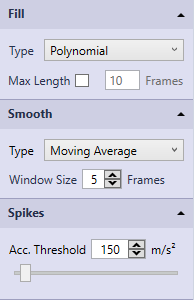Settings sidebar
In the settings sidebar of the Trajectory Editor window you can select methods for gap filling and smoothing, and change their parameters. In addition, you can set the spikes detection level.
The following gap fill types are available. For more information on how to use the different gap fill types, see chapter Filling of gaps.
-
Static
Gap filling by adding a fixed 3D position (virtual point). -
Linear
Gap filling by means of linear interpolation. -
Polynomial (default)
Gap filling by means of a cubic polynomial interpolation. -
Relational
Gap filling by interpolation based on the movement of surrounding markers selected by the user. -
Virtual
Gap filling by adding a virtual trajectory based on the movement of surrounding markers selected by the user and an optional offset. -
Kinematic
Kinematic gap fill of markers associated with skeleton segments or rigid bodies.
The following smoothing methods are available. For more detailed information about smoothing, see chapter Smoothing.
-
Moving average
Smoothing by means of an unweighted moving average. -
Butterworth
Smoothing by means of a Butterworth filter.
The spikes detection is based on a threshold of the acceleration magnitude. The threshold level can be adjusted to control the strictness of the spike detection.
